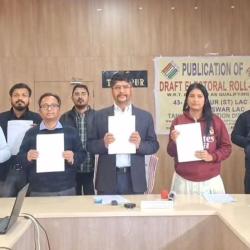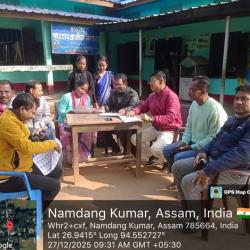How conflict affects students’ lives
The Bodo community of Assam is the worst sufferer of the policy of illegal migration for rise in the number of voters. This group of people are the most affected by the ‘Vote-Bank’ scheme of the Government of India in collaboration with successive Governments of Assam (demo-cratically elected since post-‘independence’).
The worst affected districts of Western Assam, due to such politically motivated “Chain Migration” has got an autonomous council, but only in name. The so called ‘minority’ calls the shots when a Government is to be formed at Dispur as well as Delhi. Parts of Western Assam are facing the brunt of such myopic policies of policy-makers who win elections on quantity of votes and not quality of votes. The student fraternity is the most affected by violence among different groups which spread out to different communities in no time…..like wild-fire it engulfs the dream of many meritorious students of either groups. Many students suffer due to bandhs and curfew and cannot attend schools and colleges during riots. They have to compromise with education. Schools have to provide shelter to people who have lost their houses and resources back in their villages. All government schools become temporary make-shift camps.
Let’s take the case of two young girls from the riot affected BTAD (Bodoland Territorial Autonomous Disctricts). They are not direct victims, but indirectly there Education suffers during periods of riot every now and then. Anima Hajuari (19) of Udalguri studied upto the tenth standard. She supports herself as a maid in service in different households. Anima, being born to an economically challenged family couldn’t avail tuitions to clear her exams properly. She tried to be as regular as possible in school. She says, “There are bandhs off and on. We miss classes. We miss lessons. The areas in subjects which are beyond understanding goes on left out and exams come by. Sometimes we have to lose valuable years of education as we cannot clear our test exams. The frequent bandhs and riots make the schools make-shift shelters for the riot affected people.”
There is the 22 year old nurse Sumitra Basumatary who has learnt to be financially independent because of a diploma course in nursing after matriculation exams. The vocational education has made her self-reliant. But she rues over the loss of working days in schools and her hopes of going to a college for graduation courses. Sumitra says, “Most of the time around the year, schools are off. Even if the teacher has to come as per government notice, how can the students come, especially the safety of girls is a matter of concern.” However, both Anima and Sumitra have accepted life as it comes and tries to be happy in the imperfections of life and living. Deep scars lay hidden in the dreams that catch fire every now and then.
Recently, Assam is in news because of the conflict between the native population and illegal immigrant Bangladeshis. The immigration took momentum in 1930s and later in 1970s. The flood gates of immigration have put immense pressure on the availability of land for cultivation.
Assam supplies 55 percent of the total tea produced in the country. It supplies almost 100 percent of India’s plywood needs. Over and above this, a considerable amount of coal, jute, timber, and 95 percent of the world’s syllemnite are produced in Assam. About Rs. 3000 crores (nearly $ 3 bn) worth of goods are pumped into the rest of India from Assam every year. (Tales of Western Inspiration and Indian Karma : Dilip K. Datta)
The first Mughal attack Assam was in 1205-06 A.D. Thanks to the superior military skill shown by the soldiers of Kamrup (ancient name of Asam), they had to abandon the plan to annex Assam into the Mughal empire. But things are not the same. Now we have a democracy, a democracy of numerical majority where the number of heads count more than borders. The flood-gates of immigration were thrown open by the provincial government of 1930s lead by Muslim League. It was against this background, that in his 1931 report, the then Census Superintendent, Mr. C.S. Mullan said, “In fact the way in which they (immigrants from East Bengal) have seized the vacant areas in the Assam Valley seems almost uncanny.” The silent invasion began around 1911 and the census report did mention of the horde which now has become politically motivated to the core because of their growing numbers in a ‘democracy of numbers’.
Other Contents by Author
In the 7th century AD, when Buddhism was strengthening its hold over North India, a group from the priest class forwarded a new concept to arrest the growth of Buddhism. Gautam Buddha was declared the ninth incarnation or 'avatar' of Lord Vishnu (the Protector God of the Hindu Trinity). That gave a death blow to the expansion of Buddhist faith and ideals in the country of its origin.
Likewise, the stories of Maoists forming forum to resist big dams cooked in the power corridors of Delhi to be fed to the masses through the'Tarun Gogoi's and 'Nabam Tuki's of weak states like Assam and Arunachal Pradesh holds no water. Here we can quote the famous lines of Abraham Lincoln, "You can fool some...
On December 19, the Assam Assembly adopted an unanimous resolution urging the Central Government of India to confer the highest civilian award ‘Bharat Ratna’ on Bhupen Hazarika posthumously. There are worthier things to do other than wasting the tax-payers’ money in assembly sittings for ‘resolutions’ of this type. Just as Jitumoni Kalita’s winning a dance competition, Debojit Saha winning a singing competition or Ananya Banajyotsna participating in talent ‘hunt’ shows is not going to help the masses of Assam, so also Assam MLAs begging for ‘Bharat Ratna’ to Bhupen Hazarika is not going to help the cause of the state and its people...
Home loan, car loan, education loan, health loan, travel loan….life on loan. 20 years down the lane of liberalization, this is where the great middle class in India finds itself. As if the burden of the three ancient ‘celebrations’ was not enough. The just mentioned trio is birth, marriage and death, of them, marriage being the most taxing. In village economy, the life of a Hindu family used to be caught in three debts owing to janma (birth), vivaha (marriage), mrityu(death). This was a cunning strategy of the priest and the ruling class to engage the working class in economic bondage. 20th century saw the springing up of cities in India. Situation remains the same, only...
Radhika Tanwar (20) is shot dead in Delhi. We see the perpetrator of the murder in the newspapers. We see protest marches brought out for the safety of women and girls.
Any rape, any murder in the city. We see the criminals.
Tarmetla, Chattisgarh. Hurre (20) is picked up by Indian government employed armed forces to the Chintalnar police station, stripped and sexually assaulted. But we donot see the perpetrators of the crime. May we request the government of the world’s largest democracy to disclose the names and pictures of security personals and policemen involved in crime?
The most unfortunate thing is the unconsciousness of the Great Indian middle class towards the pathos,...
Once one lands in Kuala Lumpur International Airport (KLIA), it makes one realize why Malaysia has the distinction of having the world’s best airport. The accomplishments of this small country in South East Asia is to be seen. Being on a strategic sea route position in the tropics, Malaysia has seen different groups of people trade and travel enroute its shores. In Ptolemy’s map, ancient Malaysia was shown as “Golden Khersonese”. In 2010, it looks so, prosperous and improving constantly.
Malaysia has a tropical climate, if it shines in the morning, afternoon awaits rain. It was late in the evening when we reached Kuala Lumpur. Roads and the road-sides, all well-...
As soon as we landed at the Suvarnabhumi (pronounced ‘su-wan-na-poom’) Airport in Bangkok, the guide lead us to a tourist bus. In the bus, the tom-boyish jovial lady says to us, “Welcome to Thailand, the land of gold, the land of white elephant,.... .” Lets see for ourselves if these sobriquets are relevant. She went on, “In Thailand, 95% people are Buddhists. We eat meat.” The Buddhism in Thailand didn’t spread directly from India. The import was via Sri Lanka in 3rd century B.C. There more than 35,000 Wats (Buddhist monasteries or temples) in Thailand, a country of 513,115 sq. km. Whether these have been able to shape the life of the people in the...
Sept 23, 2010. All India Congress Committee (AICC) General Secretary Rahul Gandhi comes to Guwahati campus of IIT and makes a statement, “Construction of big dams in the North East is not ‘anti-people’and the concern of the common man is being given top priority.” It is baffling to come across such an insensitive remark when mass protests are going on against mega dams in Assam and Arunachal Pradesh. Three ancient tribes of the two states will suffer the most-- the Adis, the Misings and the Deuris. It seems Rahul Gandhi has not done his home work well like most politicians in India or it might be because Assam has the same party in power as at the Centre.
A...
A decade back, when in my mid-teens, I went on a trip to Kameng in neighbouring Arunachal Pradesh. I knew that my generation had been very successfully indoctrinated with the concept of Indian and India. So I was looking out for an old grandpa to know the unadulterated reality of erstwhile N.E.F.A (North East Frontier Agency). My wish was answered when I met a gaonburha (village headman), with his grandchild near a hanging rope bridge. I struck a conversation with the tiny tot and his grandpa. When I asked the gaonburha whether he thought himself to be an Indian or a Chinese, I got the most amusing answer I have ever come across till date. The grand old man said, “Xeitutu moi...
Nemati ghat in Jorhat. This is one of the three main riverine routes to reach Majuli, the largest river island in Asia. The other two river fronts being Luit-Khabalu ghat from North Lakhimpur and Dhakuakhana from Dhemaji. This Bohag Bihu, we planned a trip to Majuli and reached Nemati ghat in Jorhat to avail the ferry service of 4:30 p.m. It is the last ferry for the day. The road leading to Nemati ghat was dusty, but the sight of the ghat was disappointing. It was mud, potholes brimming with water and a bumpy, unkempt place all around. This was the doorway to Majuli, the proposed UNESCO world heritage site. Once an island of 1250 sq. km., today Majuli is a shadow of its former self with...
1925. The Nagaon session of the Asam Sahitya Sabha. The then president of the premiere literary body of the state stressed the need for the spread of women’s education. Ironically, a bamboo-net barrier segregated the women from the men present in the conference. Chandraprabha went up to the dais and denounced the practice. She called upon the women to break down the barrier that confined them--- the fences were broken down and it stays so, never to come up again. This fiery lady is Chandraprabha Saikiani, the pioneer feminist in the modern history of Assam.
Chandraprabha Saikiani was born on March 16, 1901 in Doisingari village of Kamrup district in Assam. Her father Ratiram...










Add new comment